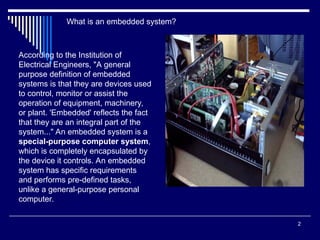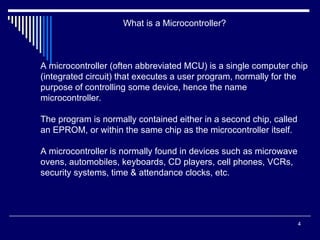Embedded System intro Embedded System intro.ppt
- 1. 1 Embedded System Introduction Dr. I. Arul Rayappan Associate Professor of Physics, St. Joseph’s College (Autonomous), Tiruchirappalli-620 002.
- 2. 2 According to the Institution of Electrical Engineers, "A general purpose definition of embedded systems is that they are devices used to control, monitor or assist the operation of equipment, machinery, or plant. 'Embedded' reflects the fact that they are an integral part of the system..." An embedded system is a special-purpose computer system, which is completely encapsulated by the device it controls. An embedded system has specific requirements and performs pre-defined tasks, unlike a general-purpose personal computer. What is an embedded system?
- 3. 3 Microcontrollers and Embedded System Embedded Systems are a combination of Hardware (microcontrollers) and Software (developed in assembler, c, c++…) designed to perform a specific function An embedded product uses microcontrollers to do one task and one task only.
- 4. 4 What is a Microcontroller? A microcontroller (often abbreviated MCU) is a single computer chip (integrated circuit) that executes a user program, normally for the purpose of controlling some device, hence the name microcontroller. The program is normally contained either in a second chip, called an EPROM, or within the same chip as the microcontroller itself. A microcontroller is normally found in devices such as microwave ovens, automobiles, keyboards, CD players, cell phones, VCRs, security systems, time & attendance clocks, etc.
- 5. 5 Microprocessor Vs Microcontroller Microcontrollers are used in devices that require some amount of computing power but donot require as much computing power as that provided by a complex (and expensive) 486, Pentium, i3 .. system which generally requires a large amount of supporting circuitry (large motherboards, hundreds of megabytes of RAM, hard drives, hard drive controllers, video cards, etc). A microwave oven just does not need that much computing power. Microcontroller-based systems are generally smaller, more reliable, and cheaper. They are ideal for the types of applications described above where cost and unit size are very important considerations. In such applications it is almost always desirable to produce circuits that require the smallest number of integrated circuits, that require the smallest amount of physical space, require the least amount of energy, and cost as little as possible.
- 6. 6 Microcontroll er CPU OSC interrupt Ext int Address Bus (Uni dirctional) Data Bus (Bi directional) Control Lines
- 7. 7 Microcontroll er CPU ROM RAM Timer0 Timer1 OSC interrupt Ext int Bus control 4 I/o ports Serial port
- 8. 8 FEATURE 8051 PENTIUM COMMENT Clock Speed 12Mhz. typical but 60MHz. ICs available 1,000 MHz. (1GHz.) 8051 internally divides clock by 12 so for 12MHz. clock effective clock rate is just 1MHz. Address bus 16 bits 32 bits 8051 can address 216 , or 64Kbytes of memory. Pentium can address 232 , or 4 GigaBytes of memory. Data bus 8 bits 64 bits Pentium’s wide bus allows very fast data transfers. ALU width 8 bits 32 bits But - Pentium has multiple 32 bit ALUs – along with floating-point units. Applications Domestic appliances, Peripherals, automotive etc. Personal Computers And other high performance areas. Power consumption Small fraction of a watt Tens of watts Pentium runs hot as power consumption increases with frequency. Cost of chip About RS.52/- About 6000/- Simple comparison: Pentium vs. 8051
- 9. 9 Microcontroller Manufacturing Companies There are FOUR major companies manufacturing 8 bit controllers 1. Motorola (6811) 2. Intel (8051 MCS51) 3. Zilog (Z8) 4. PIC (16X____) Microchip
- 10. 10 Port Organization of MCS51 Port 1 P1.0 – P1.7 Port 0 P0.0 – P0.7 Port 3 P3.0 – P3.7 Port 2 P2.0 – P2.7 P1 P0 P3 P2
- 11. 11 Port Assignments Port 0 : Input/Output Port & AD0-AD7 for ext memory Port 1 : Input/Output Port Port 2 : Input/Output Port & A8-A15 for ext Memory Port 3 : Input/Output Port P3.0 : RxD P3.1 : TxD P3.2 : INTO’ P3.3 : INT1’ P3.4 : T0 P3.5 : T1 P3.6 : WR’ P3.7 : RD’
- 12. 12 Simple Experiment in Embedded system
- 13. 13 89c51 9 +5V GND 40 18 19 20 A Circuit using 89c51 Pin 40 +vcc 20 Gnd 9 Reset 18 OSC1 19 OSC2 31 Ext Acces 31
- 14. 14 + 5 volts 10 kOhms b f e d c a g a b f e d c g + volts I-RAM 7 6 5 4 3 2 1 0 SF Rs Internal Memory B0h 90h PO RT 3 (P3) PO RT 1 (P1) P3.0 P3.1 P3.2 P3.3 P3.4 .5 .6 .7 P1.0 P1.1 P1.2 P1.3 P1.4 P1.5 P1.6 P1.7 Zone 4 Zone 3 Zone 2 Zone 1 8051 Chip Burglar alarm system hardware
- 15. 15 Switches are normally closed If any switch is opened Input x goes high to indicate an alarm condition + 5 volts input x b e d c a f g a e.g. 200 Ohm Internal circuit within 7-segment display device. (Common cathode i.e. +5v input causes LED to light) Input circuit Output circuit
- 16. 16 Initialise I/O ports P1 and P3 Read port P3 Are all P3 inputs at 0 YES NO Sound alarm Bell ALARM_1 Program flow chart
- 17. 17 ORG 0000h ; define memory start address 000 ; Initialise the I/O ports MOV P3, #0ffh ; write all ones to P3 to use as an input port MOV P1, #00 ; all zeros to put P1 in a known output state POLL: MOV A, P3 ; read P3 to accumulator CJNE A, #00h, ALARM ; if not all zeros then jump to ALARM LJMP POLL ; else loop back to POLL ALARM: SETB P1.7 ; enable the BELL by setting P1.7 high END_LOOP: LJMP END_LOOP ; program just loops around here END ; end of program ALARM_1 Program source code
- 18. 18 8051 Port 1 P1.0 + volts Loudspeaker Clock 12 MHz. RESET delay 1 ms. delay 1 ms. delay 1 ms. delay 1 ms. delay 1 ms. SETB P1.0 SETB P1.0 SETB P1.0 CLR P1.0 CLR P1.0 CLR P1.0 T = 2 msecs. f = 1/T = 1 / 0.002 = 500 Hz. P1.7 Hardware circuit with timing diagram for sound
- 19. 19 Interactive Vehicle Tracking System It is a system which can track the vehicles for its movement through out the trip with GPS And GPRS. The data collected at different data points are stored at the vehicle itself and in the computers of respective data points then to the server. The Data are vehicle number, started time, stop time, Fuel at, Date, Fuel type, Qty, Amount, Balance, Driver ID ….. The Data Points are the places where the interactive RF transmitter and receivers are fixed say BPCL fuel stations.
- 20. 20 At the data points GPS & GPRS based RF transmitter and receivers (RF System) are connected to a computers GPS system is capable of interacting over area of 1 square metre The GPS will transmit the data in a periodic interval continuously from the data point
- 21. 21 Block diagram of data locker sensors D i s p l a y alarm Micro Controller Memory Start/stop Load Fuel Transmitter Receiver GPS & GPRS Server
- 22. 22 Block diagram of data point Micro Controller Pump Printer Server SMS Pump link circuit Transmitter Receiver GPS & GPRS
- 23. 23 Advantages • Compatible with any SMART cards • Data is stored at data point (fuel station computer) and at the vehicle •Vehicle owners can verify trip data from their office • Data can be online with server • Data can be on auto SMS from vehicle(GSM/CDMA/GPRS) • Owners of the vehicles and dealers are not at the dark, but given with lot of information about their vehicles for analysis • 100% automated system
- 24. 24























